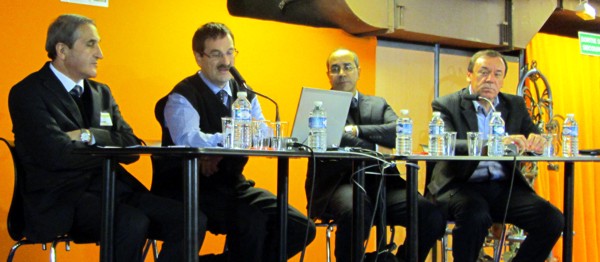These days all pest management events have an almost obligatory programme of seminars running alongside the main exhibition. Parasitec was no exception and the programme attracted plenty of interest among visitors with the 120 seater room frequently full to capacity.
Two sessions caught our eye: A multinational session on Pest control in the city and a technical presentation entitled Alternative methods of control in rodents: myth or reality?

The pest control in the city speakers. From left Metin Acar, Josá©-Maria Camara Vicario,
Takfine Herrak and AndreᯠLá©ca
|
Pest control in the city The second speaker was from Morocco. Takfine Herrak from the Ministry of Health emphasised the public health imperatives of pest control in his country. He outlined the key disease threats – malaria, bilharzias and leishmanioses – and the role that insect and rodent pests have in spreading these. The authorities in Morocco are proud that since 2004 there have been no cases of indigenous malaria in the country. Biological controls – fish to eat the larvae – physical barriers and chemical controls have all played their part in eradicating the disease. Bilharzia has also been eliminated but the authorities continue to monitor the situation. From the Romanian trade association, AndreᯠLá©ca explained how, over the past 20 years, the city has tackled its severe pest problems – in 1995 it was listed by the World Health Organisation as the top city for rats – it was estimated that there were six rats for every inhabitant so the city then was infested by some 12 million rats. Drawing on expertise from manufacturing companies, (LODI France got a specific mention), the Romanian authorities set about appointed a service provider and began an intensive baiting programme. This has been followed by a more targeted programme involving local community organisations, housing associations and so on. The final session was by way of an introduction to next year’s Parasitec, which will be in Istanbul. Metin Acar from the Turkish association HASKOD described the pest control market in Turkey. He explained that its origins go back to the 1950s/60s when the Ministry of Health developed a malaria eradication programme. In the 1980s, the municipalities took the lead then, in the 1990s the private PCO sector began to flourish as the big multinational pest control businesses entered the market. |
|
|
In the 2000s this changed and now there is a mixture of small private sector companies as well as the big multinationals and public municipalities. It is estimated that there are today around 900 PCO companies and HASKOD represents some 100 of these. There is a lot of bureaucracy. PCOs work under licence from their municipality but if they want to work in another city they must apply for another licence from that city. Alternative rodent control methods He covered other well worn topics such as the need for rodenticides to be slow acting so that the rats don’t associate eating the bait with feeling ill and the problems of secondary poisoning. He discussed too the changes in the public’s attitude to killing rats – ten years ago it was seen as acceptable but it is now much less so. He considered a number of alternatives such as:
Of these Dr Lasseur felt that ultrasonics could have a role. He outlined his research which showed that ultrasonics, especially combined with seismic vibrations, will deter rats. It doesn’t kill them, of course, or prevent them from returning once the equipment is turned off, but it can successfully protect vulnerable areas such as kitchens. Other topics |
|




